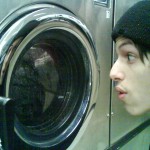Sometimes, when you’ve worked on one shot for too long, you can go a bit blind. It’s a very specific kind of blindness, one that prevents you from seeing mistakes you’ve made and opportunities you may have missed. It seems to happen to every animator at some point, and it is deadly to the creative process.

There are tricks you can use to get around it. You can hold a mirror up to the screen to see the shot from a fresh point of view. You can step away for a few minutes, or a few days, or longer. (One time I was able to step away from a shot for a full year: boy did I see it with fresh eyes at that point!) And of course you can show other people. But once the effect has set in, your own perceptive powers are severely diminished.
I have a hunch that the main cause of this is the simple act of watching your shot over and over again. In psychology there’s a concept called habituation: any stimulus repeated long enough reduces your sensitivity to that stimulus. It’s the reason why you notice the sound of the dishwasher when you first walk into the kitchen, but eventually it fades into the background.
In the early days of animation, watching a shot in progress play back at full speed was a luxury animators didn’t have. To do that required shooting key drawings onto film, developing the film, threading it into a projector, and so on: an expensive and time consuming process. And yet, great animation still got made: animators planned very carefully and learned to do most of the work in their heads. In the early days of computer animation, it was much the same, though for different reasons: we’d have to wait for an overnight render to see our work at speed.

Nowadays, animators have digital tools that allow for instant, real-time feedback, which for the most part is a tremendous aid. But it also makes it very easy to hypnotize yourself with all those looping stimuli.
If you want to stay sharp, it’s critical that you delay the onset of animation hypnosis as long as you possibly can. So what I try to do is avoid watching my shot while I’m working on it. I’ll watch it once, twice, maybe three times, and then jot down my thoughts about what needs doing. Then I go to work, keeping narrowly focused on each detail as I go. If I have to play some part of the shot at speed to judge some nuance of weight or gesture, I’ll hide everything but the body part I’m working on, so as not to get distracted. Once I’ve addressed all of my notes, only then will I watch the shot as a whole again. It takes a kind of discipline that I can’t always muster. But when I succeed, it feels great. And as a side benefit, I find I get more real work done in less time: after all, time spent looking at your shot is not time spent working on it.

I’d love to have some way of counting how many times I’ve looped my shot, to see if there’s a certain magic number where hypnosis sets in. What would that number be? 500? 5,000? You could make a game of it, a la “Name That Tune”: challenge yourself to finish a shot with the absolute minimum of viewings. How low could you go? Ten loops? Three loops? Zero?

Great post – I certainly think I can be guilty of letting the shot play for too long or too many loops, and you do lose the fresh eyes very quickly.
Three times and then make a hit list of things to fix is a good method going forward.